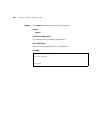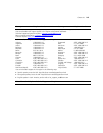241
Multicast Switching A process whereby the switch filters incoming multicast frames for
services for which no attached host has registered, or forwards them to
all ports contained within the designated multicast VLAN group.
Out-of-Band
Management
Management of the network from a station not attached to the
network.
Port Authentication See IEEE 802.1X.
Port Mirroring A method whereby data on a target port is mirrored to a monitor port
for troubleshooting with a logic analyzer or RMON probe. This allows
data on the target port to be studied unobstructively.
Port Trunk Defines a network link aggregation and trunking method which
specifies how to create a single high-speed logical link that combines
several lower-speed physical links.
Power over Ethernet
(PoE)
Power over Ethernet provides power to devices over existing LAN
cabling, without updating or modifying the network infrastructure.
Power over Ethernet removes the necessity of placing network devices
next to power sources.
Private VLANs Private VLANs provide port-based security and isolation between ports
within the assigned VLAN. Data traffic on downlink ports can only be
forwarded to, and from, uplink ports.
Protected Extensible
Authentication
Protocol (PEAP)
A protocol proposed by Microsoft, Cisco and RSA Security for securely
transporting authentication data, including passwords, over 802.11
wireless networks. Like the competing standard Tunneled Transport
Layer Security (TTLS), PEAP makes it possible to authenticate wireless
LAN clients without requiring them to have certificates, simplifying the
architecture of secure wireless LANs.Protocol-Independent Multicasting
(PIM)
This multicast routing protocol floods multicast traffic downstream, and
calculates the shortest-path back to the multicast source network via
reverse path forwarding. PIM uses the router’s IP routing table rather
than maintaining a separate multicast routing table as with DVMRP.
PIM - Sparse Mode is designed for networks where the probability of a
multicast client is low, such as on a Wide Area Network. PIM - Dense
Mode is designed for networks where the probability of a multicast
client is high and frequent flooding of multicast traffic can be justified.


















